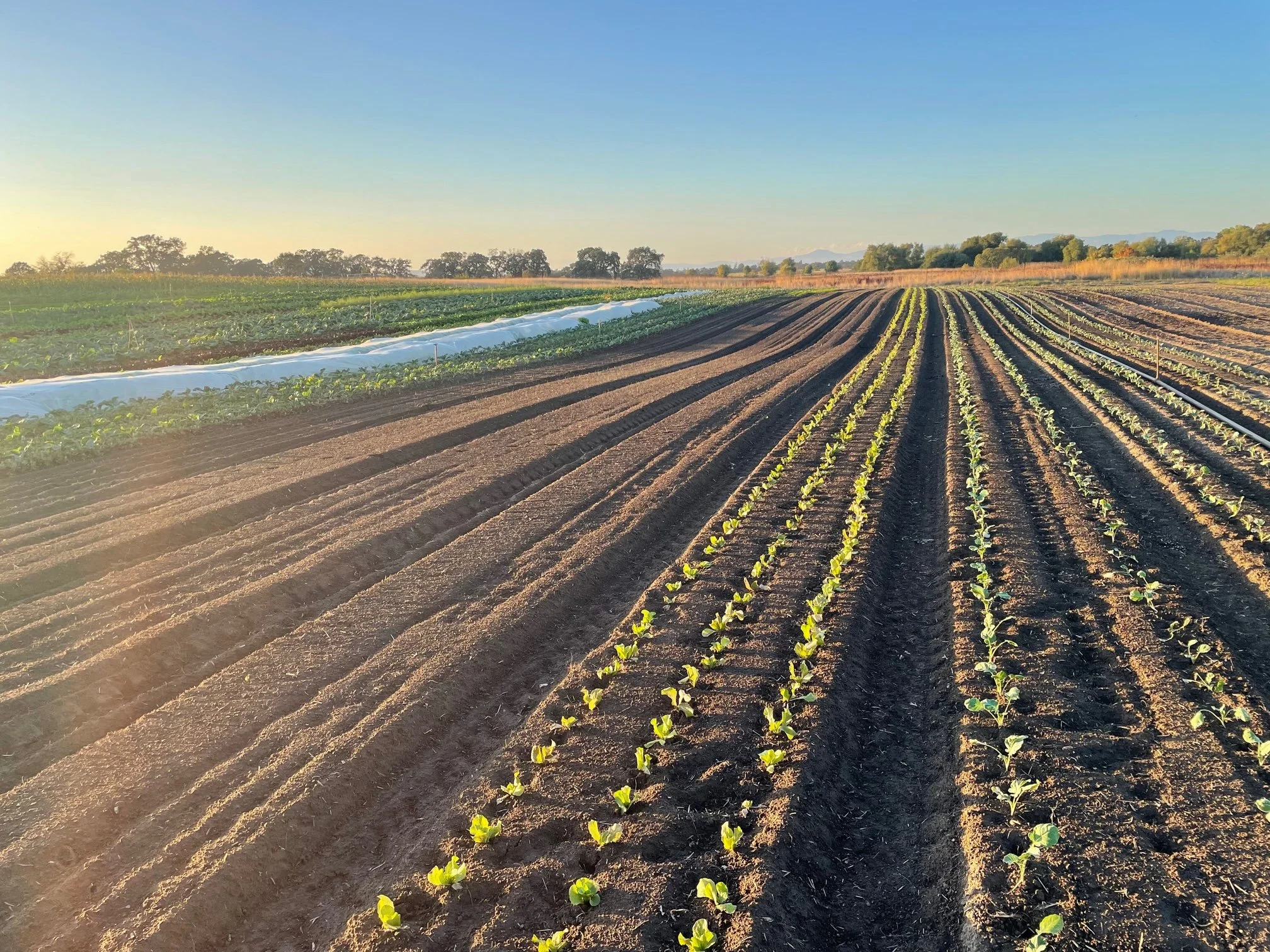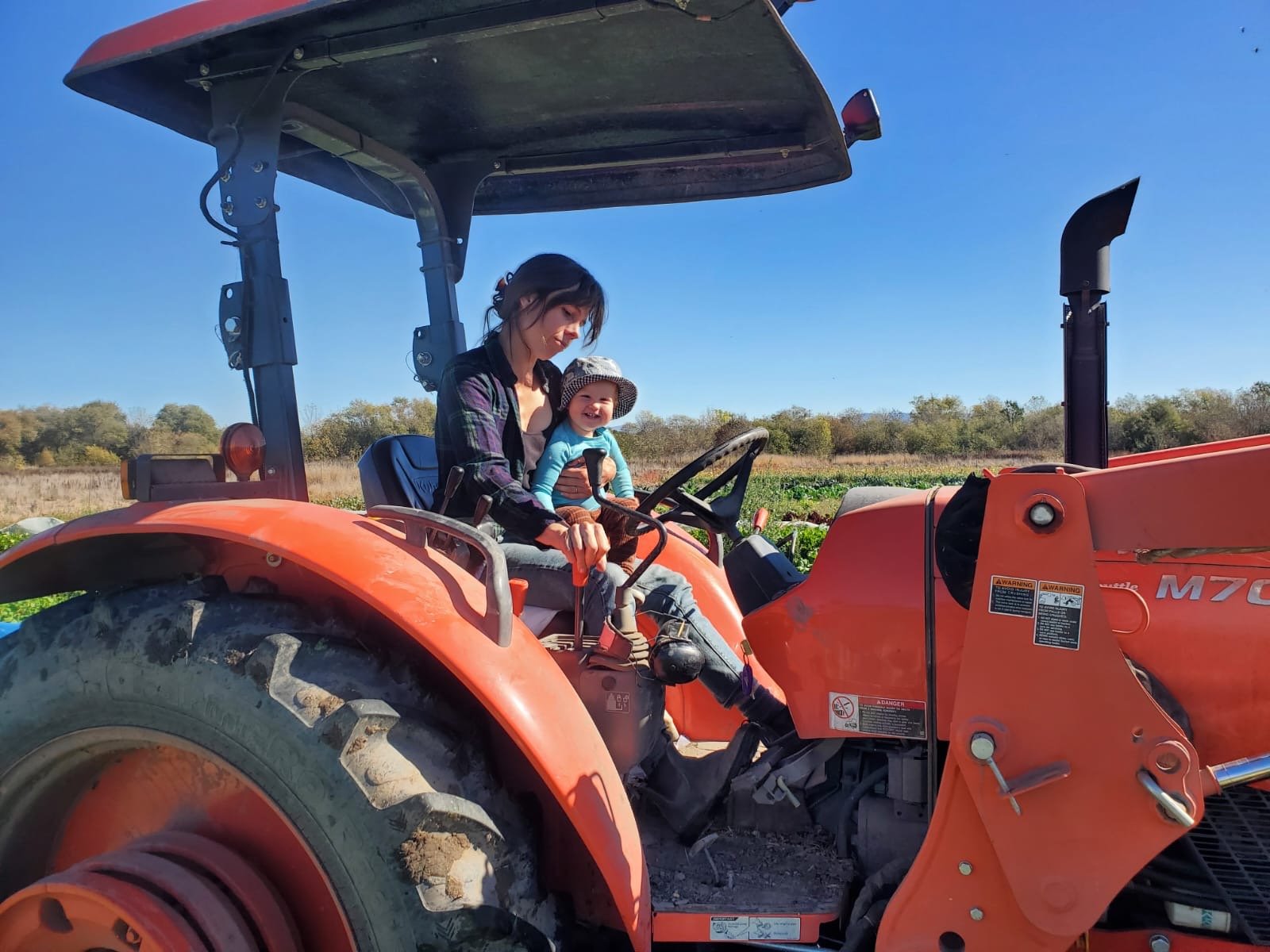THIS WEEK’S HARVEST
Yukon Gold Potatoes, Jester Winter Squash, Red Cabernet Onions, Garlic, Bolero Carrots, , Green Magic Broccoli, Bishop Cauliflower, Romanesco Cauliflower, Hakurei Salad Turnips, Indigo Radicchio, Rainbow Chard, Red Salanova Oakleaf Lettuce, Spinach
U-PICK
After a series of frosts this week, all but the most hardy of the flowers and herbs are done for the season. Miraculously, we still have a few strawberries hanging on, but they’ll continue to get more scarce as the nights cool.
Albion Strawberries | 1 pints per share
HARVEST NOTES
Jester Acorn Winter Squash: A true gem. A super sweet Delicate that looks like an Acorn. A hard ribbed shell hides pudding-sweet flesh. A good Jester can be among the sweetest of all winter squashes. David's favorite. Try halving long ways, scooping out the seeds, and roasting at 400 until you can poke a fork in the skin and the flesh is soft and creamy. Add a dash of water to the baking sheet while roasting to keep your squash moist. Eat straight out of the shell with a spoon like pudding! Try adding butter, coconut oil, and/or maple syrup to and eating out of the shell with a spoon.
Romanesco Cauliflower: Sometimes called Romanesco Broccoli, this spectacular Italian heirloom grows in green spires that look like tiny fractal Christmas trees when cut. It has a Cauliflower-like texture and flavor but with a little extra nuttiness. Prepare like you would Cauliflower.
Swallowtail caterpillars on the dill in the garden. There are lots to see if you look for them! Photo by Asa.
FALL HARVEST POTLUCK PARTY!
Sunday, November 17th, 2024 — 3:30 pm
CSA member Carl Jaeger has volunteered to organize a fun and festive Harvest Potluck Party here on the farm on November 17th! Come chow down and mix and mingle with fellow CSA members. You should have gotten an an email with more information and a chance to RSVP. Let us know if you didn’t receive it, and want to!
HOW TO BOIL VEGETABLES
AND A RECIPE FOR PASTA WITH BOILED CAULIFLOWER, ROMANESCO OR BROCCOLI
We learned this way of preparing vegetables from one of our most-beloved cooking texts, An Everlasting Meal: Cooking with Economy and Grace by Tamar Adler. Rather than elaborate recipes, Adler’s book is full of a poetic philosophy of cooking and simple techniques that can humbly revolutionize one’s approach to feeding oneself. Here’s an excerpt from the first chapter of her book, called How to Boil Water, on how to boil vegetables deliciously.
“To boil broccoli or cauliflower, cut off the big, thick, main stem, or core. Cut the remainder of the heads into long pieces that are more like batons than florets, including stem and leaves on as many of them as you can. Cut the stem or core you’ve removed into equivalent-sized pieces and include them in your boiling.
Bring a big pot of water to boil, add salt, and taste. Drop the vegetables into the water and then let them cook, stirring once or twice. This does not, contrary to a lot of cooking advice, take only a minute. You don’t need to stand over the pot, because your vegetables don’t need to be “crisp” or “crisp-tender” when they come out.
For boiled vegetables to taste really delicious, they need to be cooked. Vegetables are done when a sharp knife easily pierces a piece of one. If you’re cooking broccoli or cauliflower, test the densest part of each piece, which is the stem. Remove the cooked vegetables from the water with a slotted spoon directly to a bowl and drizzle them with olive oil. If there are so many that they’ll make a great mountain on each other, with the ones on top prevailing and the ones at the bottom of the bowl turning to sludge, spoon them onto a baking sheet so they can cool a little, and then transfer them to a bowl.
Corn stubble being spaded under to make way for for cover crop seed. The worms will be eating well this winter!
A plate of boiled vegetables can be dinner, with soup and thickly cut toast rubbed with garlic and drizzled with olive oil. If you boil a few different vegetables, cook each separately. Dress each of them like you do broccoli, with olive oil, and if they’re roots or tubers, like turnips or potatoes, add a splash of white wine vinegar or lemon while they’re hot.
Once you have a vegetable cooked, you can cook a pound of pasta in the same water and use the boiled vegetable to make a wonderfully sedate, dignified sauce by adding a little of the pasta water, good olive oil, and freshly grated cheese.
Boiled broccoli and cauliflower both take particularly well to this.
Put two cups of either vegetable, boiled until completely tender and still warm, in a big bowl and leave it near the stove. Bring its water back to a boil and adjust its seasoning. If the water is too salty, add a bit of fresh water. When the water returns to a boil, add a pound of short pasta, like penne, orecchiette, or fusilli.
While the pasta is cooking, smash your vegetable a little with a wooden spoon and grate a cup of Parmesan or Pecorino cheese into the bowl.
Taste a piece of the pasta by scooping it out with a slotted spoon. When the pasta is nearly done, remove a glass of the pot’s murky water. This will help unite pasta, vegetable, and cheese. If you think you’ve pulled the water out before it’s as starchy and salty as it can be, pour it back and return for saltier, starchier water a minute or two later.
Scoop the pasta out with a big, handheld sieve or drain it through a colander and add it to the bowl with the vegetable and cheese, along with a quarter cup of pasta water, and mix well somewhere warm. This is always a good idea when you combine ingredients. Heat is a vital broker between separate things: warm ingredients added to warm ingredients are already in a process of transforming. They’re open to change.
This pasta is good as is, but is improved by a big handful of chopped raw parsley or toasted breadcrumbs.”
WINTER SISTER FARM CSA STARTING SOON!
Going to miss us this winter? Well you’re in luck! Our dear friends next door at Winter Sister Farm have got you covered with the freshest veggies money can buy all winter and spring.
Memberships include diverse winter-hardy veggies such as broccoli, carrots, potatoes, onions, winter squash, lettuce, kale, chard, as well as access to a small u-pick garden with cold hardy herbs and spring flowers. Click here to get all the details on this wonderful CSA program and to reserve your spot today!
FARMER’S LOG
Co-Creation
Today we wanted to leave you with the inspiring words of our distant comrade in farming, Cate Casad of Casad Family Farms in Madras, Oregon.
Frostcicles on the kale this morning.
“365 days a year we get to vote for the world we participate in creating. We wake up and we dress ourselves in a version of the free market capitalism we participate in; is it fossil fuel derived textiles or natural fiber textiles you put on? We walk to the kitchen and start the water for tea or coffee — are those beans products of equitable employment for someone in Costa Rica? We decide to whom we want to give our attention by opening up a social media app, a book, a podcast, or we choose silence and self. We meander to the kitchen for breakfast, is the food from your local economy, helping to provide jobs in the community and decentralized food systems? As the day winds on, more and more decisions as ubiquitous as a left turn or a right turn are presented, and each decision is a vote for the version of ourselves we carry forth and the version of this world we participate in carrying forth.
So today, tomorrow, and the next day, VOTE.”
Thanks for voting to co-create this community farm with us this year and for supporting your regional food system.
Casad Family Farm raises and ships regeneratively grown meat. To learn more about their offerings visit their website here.
See you in the fields,
David
CSA BASICS
What time is harvest pick-up?:
Saturday harvest pick-ups run from 9:00 am - 2:00 pm
Tuesday harvest pick-ups will run from 1:00 pm - 6:00 pm
Oriented members can come to the farm any time, 7 days a week, sunrise to sunset, to u-pick and enjoy the farm.
Where is the farm? The member parking lot is located at 1720 Cooper Rd., Sebastopol, CA 95472.
Where is the food? The produce pick-up barn is just to the right of the solar panels and above our big greenhouse. You can’t miss it!
2024 CSA program dates: Our harvest season will run from Saturday, June 15th through Tuesday, December 10th this year.
Drive slow! Please drive slow on Cooper Rd. and in our driveway / parking lot area. Kids at play!
No dogs: Unfortunately, dogs are not allowed on the farm.













